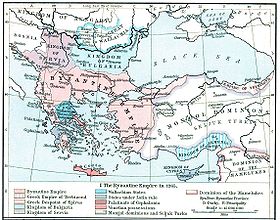- Despotate of the Morea
-
Despotate of the Morea
Δεσποτᾶτον τοῦ Μορέως← 
1349–1460  →
→The Despotate of Morea in 1450 Capital Mystras Language(s) Medieval Greek Religion Eastern Orthodox Church Government Principality Despot - 1349 – 1380 Manuel Kantakouzenos - 1449 – 1460 Thomas Palaiologos Historical era Late Medieval - Established 1349 - Disestablished 1460 The Despotate of the Morea or Despotate of Mystras (Greek: Δεσποτᾶτον τοῦ Μορέως, Δεσποτᾶτον τοῦ Μυστρᾶ) was a province of the Byzantine Empire which existed between the mid-14th and mid-15th centuries. Its territory varied in size during its 100 years of existence but eventually grew to take in almost all the southern Greek peninsula, the Peloponnesos, which was called Morea in the medieval period. It was usually ruled by a close relative of the current Byzantine emperor, who was given the title of despotes (in this context it should not be confused with despotism). Its capital was the fortified city of Mystras, near ancient Sparta, which became an important centre of Byzantine culture and power.
The Despotate of the Morea was carved out of territory seized from the Frankish Principality of Achaea. This itself had been carved out of former Byzantine territory following the Fourth Crusade (1204). In 1259, the Principality's ruler William II Villehardouin lost the Battle of Pelagonia against the Byzantine Emperor Michael VIII Palaeologus. William was forced to ransom himself by giving up most of the eastern part of Morea and his newly built strongholds. The surrendered territory became the nucleus of the Despotate of Morea.
A later Byzantine emperor, John VI Kantakouzenos, reorganized the territory in the mid-14th century to establish it as an appanage for his son, the Despot Manuel Kantakouzenos. The rival Palaiologos dynasty seized the Morea after Manuel's death in 1380, with Theodore I Palaiologos becoming despot in 1383. Theodore ruled until 1407, consolidating Byzantine rule and coming to terms with his more powerful neighbours – particularly the expansionist Ottoman Empire, whose suzerainty he recognised. He also sought to reinvigorate the local economy by inviting Albanians to settle in the territory.
Subsequent despots were the sons of the Emperor Manuel II Palaiologos, brother of the despot Theodore: Constantine, Demetrios, and Thomas. As Latin power in the Peloponnese waned during the 15th century, the Despotate of the Morea expanded to incorporate the entire peninsula in 1430 with territory being acquired through dowry settlements, and the fall of Patras to Constantine. However, in 1446 the Ottoman Sultan Murad II destroyed the Byzantine defences on the Hexamilion wall at the Isthmus of Corinth. His attack opened the peninsula to invasion, though Murad died before he could exploit this. His successor Mehmed II "the Conqueror" captured the Byzantine capital Constantinople in 1453. The despots, Demetrios and Thomas, brothers of the last emperor, failed to send him any aid, as Morea was reeling from a recent Ottoman attack. Their own incompetence at rule led to an Albanian-Greek revolt against them, when they invited in Ottoman troops to help them put down the revolt. At this time, a number of leading Moreote Greeks and Albanians made private peace with Mehmed.[1] After more years of incompetent rule on the part of the despots, their failure to pay their annual tribute to the Sultan, and finally their own revolt against Ottoman rule, Mehmed came into the Morea in May 1460. By the end of the summer he had achieved the submission of all Byzantine-held cities. The only non-Ottoman territories were held by Venice: the port cities of Modon and Koroni at the southern tip of the Morea, the Argolid with Argos, and the port of Nafplion. Monemvasia subsequently surrendered itself to Venice at the beginning of the 1463-1479 Ottoman-Venetian war.
Byzantine despots of the Morea
- Manuel Kantakouzenos (1349-?)
- Michael Asan ?
- Andrew Asan (?-1354)
- Manuel Kantakouzenos (restored) (1354-1380)
- Matthew Kantakouzenos (1380-1383)
- Demetrios I Kantakouzenos (1383)
- Theodore I Palaiologos (1383-1407)
- Theodore II Palaiologos (1407-1443)
- Constantine Palaiologos (1428-1449), after 1449 became emperor at Constantinople. Thereafter, joint rule between his brothers:
- Thomas Palaiologos (1428-1460)
- Demetrios II Palaiologos(1449-1460)
References
See also
- Byzantine Greece
Categories:- Former principalities
- Former countries in the Balkans
- States and territories established in 1349
- States and territories disestablished in 1460
- 1460 disestablishments
- Despotate of the Morea
- Byzantine Empire successor states in the Balkans
Wikimedia Foundation. 2010.


